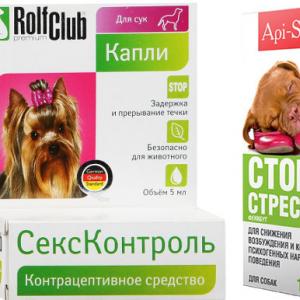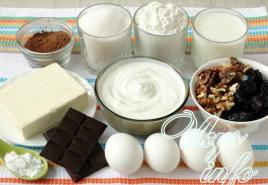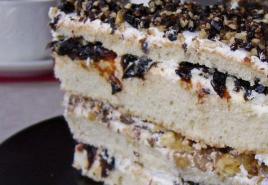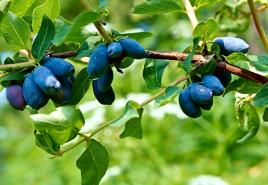Silver pheasant. Golden pheasant and other breeds of exotic birds for decorative and meat production Silver pheasant content
For professional rearing, the silver pheasant is a tempting proposition. Let's look together at the features of breeding silver pheasant and diet.
This is one of the most attractive and beautiful birds, which has a wide and long crest on its head with black plumage. The front of the head is without feathers, but it is painted in a bright red hue. Weight adult ranges from 4 to 6 kg, and height - 30-40 cm. I would like to highlight the endurance of these birds: they easily get used to even the most unfavorable living conditions and are not afraid of cold weather. Moreover, the birds are perfect for growing in confined spaces.
Silver pheasants can be bred only for eggs - this individual has a high level of fertility. After one mating season, the female can lay up to 40 eggs. Moreover, the meat turns out to be dietary, healthy, and tasty. Therefore, this species of the pheasant family is ideal for breeding for meat.
Distinctive features of raising birds
The silver pheasant is perfect for breeding in captivity. If you are a beginning farmer, then this subspecies is a great start. Birds are unpretentious, love to eat everything, and are reserved during mating games. The pheasant has a good memory, so it can remember the face and behavior of its owner, gets used to it, and becomes docile.
Incubation period
In order for chicks to be born, pheasant eggs need to be heated. The main thing is that the floor in the house is concreted, since the penetration of rodents and predators in this case is dangerous. Wooden parts are laid on the concrete, then everything is covered with sand and dry straw. The chicks will stay in such a homemade nest for one and a half months.
Before the chicks are born, you need to disinfect the place: soda is ideal as an antimicrobial agent. The temperature in the incubator should be +37 degrees, and incubation period is 25 days.
Caring for baby pheasants
When the chicks are born, they need to be fed through a special feeder; there is no need to let adult birds into the common enclosure. The amount of food and water should be checked regularly and, if necessary, replenished 4 times a day.
If it is a hot summer, you will also have to control the temperature in the room to ensure comfortable conditions for the chicks. Chicks can be allowed into an open cage a month after their birth. The pheasants should not be crowded in the cage: there should be 30 chicks per 1 square meter.
In the first days after birth, chicks need a temperature of about +28 degrees, then the temperature gradually decreases to +20 degrees. The diet of phasonites should consist of hard-boiled eggs and finely chopped greens. In the second month of life it is necessary to give adult food. Once the chicks are 5 months old, they are considered adult birds.
The room for breeding pheasants should be in a dry place on a small hill. It is better to cover the floor in the aviary with fine gravel or river sand - such a covering will provide good sanitary and hygienic conditions for keeping birds. On the outside, the frame of the enclosure must be lined with a mesh with cells of 1.5 by 1.5 cm.
You cannot use chain-link mesh to cover the aviary, as birds are often injured by sticking their beaks and heads into the cells. In summer, it is better to equip the aviary with a canopy, under which the birds will hide from the sun and rain. There should be 1.5 square meters per pheasant: build the enclosure based on this. If you plan to breed several pheasants in one enclosure, 4 square meters will suit them.
A group of silver pheasants will comfortably fit in an enclosure with an area of 10-16 square meters. Silver male pheasants should be kept in different enclosures, as these birds are aggressive and often get into fights. The enclosure must be kept clean and tidy, and the room must be constantly treated with antimicrobial agents. It is also important to regularly remove any remaining food from bowls and drinkers and change the water to prevent bacteria from growing.
Silver pheasants are unpretentious and eat all types of feed with great pleasure. You can feed the birds the following foods:
- fresh and dried herbs;
- insects;
- fruit and vegetable peels;
- grains

The basis of the diet is grain mixtures of corn, wheat and barley. If you want to increase the productivity of pheasants, you can include the following in your menu: nutrients: fish oil, chalk and flour. The main condition for except is quality and freshness.
If the pheasants suddenly eat rotten, expired food, the sensitive silver pheasant will experience an upset stomach, and if its immunity is low, it will catch an infection. This breed of pheasant has an excellent appetite. And if the diet is carefully thought out and balanced, this will have a beneficial effect on further reproduction throughout the year. In winter, the diet should be nutritious and consist of fortified feed.
The silver pheasant is not an ornamental species, like the golden one, and rarely gets sick. The main signs of bird disease are changes in behavior:
- lethargy;
- loss of appetite;
- loss of activity and energy.
At the first symptoms, you need to call a veterinarian who will examine the bird, place it in a separate cage and prescribe treatment. As for the diseases common to the silver pheasant, the following can be distinguished:
- Viral respiratory diseases.
- Smallpox.
- Bacterial diseases such as pasteurellosis and tuberculosis.

Now you know who the silver pheasant is, what its reproductive characteristics are, and what to feed it. This variety can be easily grown to produce meat, which is distinguished by small delicacy properties. Additionally, we highlight that the silver pheasant is not picky, so it is perfect even for beginners.
There are 6 silver pheasants of the nominal type living in the Russian zoo. They live outside in an enclosure on the Old Territory. Reproduction occurs regularly, with females themselves incubating the eggs and raising the chicks. The diet is the same as for other pheasants: 400 grams of plant and animal food for each bird.


You might get the impression that when describing pheasants, I only use the superlatives. But believe me, every day, caring for, feeding or simply watching them, I never cease to be amazed at the skill with which nature made them. In my opinion, it’s impossible to stop looking at the beautiful. It’s like a work of art - a painting or a statue, only everything there is static, regardless of the talent and skill of the artist, but these birds are alive and moving. We are capable if we have taken upon ourselves the responsibility to support them, to create appropriate living conditions for them, and their appearance is a worthy merit.
The silver pheasant, in my opinion, is associated with a fashionista in a snow-white tuxedo who came to the ball. The blue, almost dark with snow-white, serious outfit is complemented by a lush black crest and large bright red folds of skin around the eyes. If we add to this the habit of spreading our wings from time to time and shaking them quickly, then such associations will become clear. As for the pheasant, she is “dressed” much more modestly, but also quite elegantly. Actually, the silver pheasant is impeccable. In our opinion, the bird is for keeping on a personal plot. Firstly, these birds are very beautiful; secondly, they are perfectly tamed and, thirdly, they are probably the largest in size (at least among those that we keep at home). And in the end, in terms of egg production, they are second only to hunting phases.
Are you unhappy with the plain, gray, miserable-looking chickens and geese on your property? Do you want to have something exotic and, at the same time, not spend a lot of time and effort on caring for this creature? The golden pheasant, as well as its close “relatives”, is an ideal option for every farmer who wants to add “raisins” to the poultry house!
There are more than 30 species of pheasants on the territory of the Russian Federation. Some of them are grown only for meat, others for decorative purposes. But only a few types are considered the most successful ratio appearance and productivity. They are raised for eggs, meat, or simply to act as peacocks. Now we will look at the most prominent (in the literal sense of the word) representatives of this group and the features of their content.
- Pheasant golden. Very beautiful bird, which is grown mainly for decorative purposes. Homeland - highlands of China (from 2000 meters). Its weight reaches no more than 1400 grams (females weigh up to 1200 g). The egg production of an adult is 40 pieces per season, young hens lay up to 20, if you periodically remove eggs from the nest, you can improve these indicators by 35%. Some farmers grow this species for the purpose of obtaining dietary meat, it is very popular in restaurants. Despite such an exotic appearance, it easily tolerates frosts of -35 degrees (in an unheated winter shelter) as with. It feeds on almost everything, mainly leaves, greens and small grains. Resistance to diseases is low; it is necessary to periodically treat with broad-spectrum antibiotics. Has a golden tail, red breast and traditional of this kind birds "collar".
- Hunting pheasant. The most common species in Russia, Ukraine, Moldova, Kazakhstan and Georgia. Lives mainly in steppes, but is often found in deciduous forests, wetlands, and peat bogs. Weight reaches 2 kg (males), but, as a rule, young individuals do not grow more than 1600 g. The color is not as provocative as that of Golden pheasant, brown, red and black spots predominate for camouflage in steppe areas. Egg production ranges from 5 to 12 eggs; in captivity, up to 40 eggs can be taken if periodically taken from the nest during laying. The species is frost-resistant, can be kept outside down to -15 degrees, and can withstand any winter in an unheated house.
- king pheasant. Another “Chinese bird”, which lives high in the mountains, loves a moderately humid climate, temperatures from +15 to +20C. It feeds on insects and vegetation; when kept in captivity, it eats grain mixtures and any greens (should account for 60% of the diet). It has a beautiful color: on a dark orange, red and black background you can see white “scales”, spots that serve for camouflage. The tail is slightly longer than that of its fellows, so it more often than others ends up in enclosures for decorating summer cottages. Gets along well with poultry, does not conflict, eats everything that chicken.
- Silver pheasant. True exotic lovers are sure to keep at least a few of these birds in their aviary. We liked them for their wild nature; they are practically never tame. Their relatively large sizes make it possible to grow them not only for decorating the site, but also for the purpose of obtaining large quantity dietary meat. The body length is up to 80 centimeters (and this is without a tail!), some males grow up to 120 centimeters and weigh up to 4 kilograms. Females lay up to 40 eggs per season if kept in an enclosure; in nature, up to 15 eggs. Resistance to diseases and cold is high, the plumage is very thick, protects from frost and wind. Silver pheasant does not require special care, can be fed with almost all the food that chickens or geese eat, no pond is needed.
- Diamond pheasant. This bird is a little different from its “brothers”, as it does not have the characteristic collar that is present in the above-mentioned specimens. Its voluminous neck plumage attracts many exotic bird lovers. The weight of the male reaches 900-1300 g, the female is slightly smaller. Pheasants are practically omnivores, they eat crushed grain, millet, they are very fond of greens and root vegetables, it is advisable to give fish oil and phosphorus for better digestion and rapid weight gain. Sexual maturity occurs at the age of 6 months, up to 30 eggs are laid per season. The bird is surprisingly peaceful, tame, and feels great in a closed enclosure.
Ornamental pheasants, the breeds of which we discussed above, are not a worthy replacement, since they gain weight for a very long time, and the maximum weight does not exceed 1-2 kg. But their decorative appearance is much superior to that of the best exotic birds, and their resistance to the Russian climate allows them to be unrivaled.





Special care for pheasants and is it needed at all?
Many farmers believe that caring for exotic birds is a very difficult process that not everyone can handle. In fact, everything is much simpler. They require minimal care, and this fact is very easy to explain.
Regular broiler chicken or goose European breed- whimsical animals that have been raised by man for decades and are exclusively his creation. This is the result of crossing hybrids of the fifth or tenth generation, where natural protective mechanisms have already been completely lost. Pheasant is the original form that exists in nature. It means that their immunity is maximally adapted to the climate, they adapt to any conditions in the shortest possible time, and diseases practically do not mow them down. If you “harden” the chicks from the first days, then they will feel great in winter when temperatures are too low.
As for the special diet or conditions of detention, there is no need to fool your head. The main thing is to build a poultry house without drafts, since pheasants, like any other “settlers” of this room, can freeze very much. If there is no draft, they can easily withstand frosts down to -30 degrees even in an uninsulated building.
It is better to feed 5 times a day, 20% of the diet; overfeeding is not recommended. The bird is not voracious, eats no more than 2-3% of its weight per day, adults eat up to 1.5%. It is preferable to give green food so that the stomach digests better.
Breeding and features of caring for young animals
3 females and 1 male are selected for breeding - this is the ideal ratio that will bring the greatest productivity. They need to be kept separately for 1 to 2 weeks, only then placed in one enclosure so that their natural instincts appear. Pheasants are wild, so they need bushes and shelters to create an intimate environment so that they and their future offspring feel protected. Make canopies and fences on the site, throw a few cardboard boxes - that will be enough.
Egg laying can begin as early as April, on the 10th-15th, depending on weather conditions. If the temperature is high, then the bird begins to lay eggs early. By looking at pheasants you can determine whether there will be frost or whether the weather has already warmed up - they are universal thermometers, they never make mistakes and only lay eggs under heat. There are several rules for collecting eggs. Let's take a closer look at them.
- They must not be allowed to fall under straight lines. Sun rays, make a canopy - it will significantly increase the efficiency of breeding.
- You need to collect them at least once every 2 days, leaving 2-3 eggs in the nest and taking the others. This encourages the female to lay more. This way you can take up to 40 eggs per season.
- Try not to shake them too much - the material is very sensitive to “turning”.
- Should be stored at a temperature from +20C to +40C.
When growing in an incubator, you need to maintain a temperature of +38 degrees for the first 3-4 days, then +36C for another 5 days, then set it to +32 until the chicks hatch. They are left in the incubator for another 12 hours until they dry out. For the first 5 days they need to be given plenty of water from a pipette or syringe, fed with egg yolks, then they are gradually transferred to regular food. No more care is required, and then they can be raised in the same way as chicken.
In the past, pheasants were rarely raised at home, but these birds have now become widely popular due to their delicious meat and eggs. Keeping pheasants is practiced both for personal consumption and on an industrial scale.
This article describes the main points of raising these birds at home. You will find out what kind of care and conditions they need, and you will also be able to take advantage of practical examples arrangement of enclosures with photos and videos.
Features of care and maintenance of pheasants
The main feature of keeping them at home is the aviary, in which the birds will stay even in winter (Figure 1).
 Figure 1. Keeping females and males in enclosures
Figure 1. Keeping females and males in enclosures Representatives of this species tolerate cold well, which is possible due to the thick feather cover. The aviary must be surrounded by a net and covered with a roof, since the birds can fly away.
For adult pheasants
Adults are picky about food and require only high-quality products. They also love cleanliness in the enclosure and independently maintain the cleanliness of their plumage, and replacing water in drinking bowls and removing uneaten food from the feeder should be done in a timely manner.
Note: Raising such livestock on a personal plot requires special care, but this process pays for itself in meat products and a high level of egg production.
The diet of adults mostly consists of wheat, barley and corn. However, they can be given cake and raw vegetables, which are given in crushed form. If you need to increase productivity, you can add the following components:
- Fish fat;
- Fishmeal;
- Nutritional supplements for breeding birds.
Raising productive livestock at home is impossible to imagine without proper care for young animals, the main nuances of which will be described below.
For the little ones
Chicks require special conditions during the first month of life. In the first three days, the temperature in the room should be at least 28 degrees, which is then gradually lowered until the chicks are one month old. Already at the age of one month, small individuals can be released into the aviary, but when the temperature drops below 20 degrees, they should be driven into the house (Figure 2).
 Figure 2. Keeping chicks in a brooder and aviary
Figure 2. Keeping chicks in a brooder and aviary For food, small animals are given a hard-boiled egg, which is mixed with herbs. From the age of two months, young animals can begin to be fed according to the diet of adults.
Rules of care
Caring for pheasants when kept in household requires maintaining cleanliness in the enclosure throughout the year. In the summer, it is worth changing the water in the drinking bowls more often and cleaning the enclosure. During the winter cold, it is necessary to regularly remove snow from the enclosure. However, the water does not need to be heated (it should be cool, but not icy).
It is also necessary to treat birds with care, since they are very sensitive to stress. There should be enough feeders and drinkers in the enclosure, since stronger individuals may not allow weaker ones to approach the feeds and drinkers.
Conditions
One individual requires 1.5-2 square meters. area in the enclosure for good growth, and for a pair during the breeding season, 9.3 square meters are needed. The aviary should be surrounded with a metal mesh and its upper part covered with a soft mesh, this way you can prevent possible injury to the birds. Also, along the outer perimeter of the enclosure, various green bushes should be planted, which are readily eaten by adults and young animals.
Single males should be housed in one enclosure with four females, and family ones should be housed separately. Also, partitions should be made between such cells, since males may start fighting.
How to keep pheasants at home: video
You can see in detail how to keep pheasants at home in the video. It shows what growing and feeding conditions should be provided for birds to maintain high egg and meat productivity.
Fortunately, these birds tolerate even severe frosts well. However, individuals tolerate such cold weather best from big amount food, but at the same time it is worth making a cover with warm bedding in the enclosure (Figure 3).
The features and conditions of winter growing at home will be described in detail below.
Peculiarities
In a household, you can practice keeping it without building a poultry house for the entire livestock. It is recommended to build a cover or a small booth with warm flooring in each cage so that the birds can keep warm at temperatures below minus 20 degrees.
 Figure 3. Features of keeping an enclosure in winter
Figure 3. Features of keeping an enclosure in winter Pheasants can be kept in a cage almost all seasons of the year, with the exception of rain or snow. It is also imperative to install partitions between enclosures, since fights over territory may occur between males.
Content Rules
The floor of the enclosure should be covered with gravel or sand. The frame of the aviary should be covered with a mesh with a mesh size of 1.5 * 1.5, since chain-link is not recommended for such purposes due to the high level of injury to birds.
Note: Installing a canopy will help protect birds from the summer heat and any precipitation.
Family individuals should be placed in separate cages, and single ones in one enclosure (one male for four females). On average, one individual needs 1.5 square meters of area.
Arrangement of the enclosure
Pheasants are considered ground birds that will happily perch on low tree branches. Instead of branches, you can install small poles and the leisure of the individuals will be organized. You can also install various stone structures to decorate the interior and provide opportunities for birds to climb on them (Figure 4).
 Figure 4. Options for arranging an enclosure
Figure 4. Options for arranging an enclosure The ground can be sown with different forage grasses so that birds can feed directly from the growing greenery. Forage grasses are of great importance for a complete feeding ration.
Silver pheasant: breeding and maintenance
Representatives of this breed have a wide and long crest, on which there are thread-like plumage of black color. The front part of the head has no hair and is bald, but it has a bright red color.
Breeding this breed allows you to obtain meat carcasses containing a low level of fat.
Rules
In households, silver pheasants are unpretentious in terms of keeping conditions and can tolerate low temperatures well (Figure 5). When kept in an enclosure, males should be separated into separate cages, since they are pugnacious and can attack other individuals. Males can also attack other birds in the household.
 Figure 5. Features of the silver content
Figure 5. Features of the silver content Thanks to their strong plumage, representatives of this breed can withstand severe frosts and gusty windy weather. It is also necessary to arrange a pond near the aviary, which will serve as a large drinking bowl for birds.
Peculiarities
You can add food for geese and chickens to the feeding ration. The biggest feature of birds of this breed is their high level of egg production.
They can produce up to 40 eggs in one season. Individuals also have strong immunity and can survive most different diseases.
Diamond pheasant: content
The back and neck of the diamond pheasant are green, and the crest is red. In the belly area the plumage is yellow, but the tail is colored black. Females are much smaller in size and weight, but they begin to lay eggs from the age of six months.
Rules
Note: In aviary conditions, the birds behave very calmly and go into the arms of a person.
The feeding diet of this species is identical to that of chicken. To speed up weight gain, you should add fish oil to your food.
 Figure 6. Rules for keeping representatives of diamond rock in summer and winter
Figure 6. Rules for keeping representatives of diamond rock in summer and winter They tolerate winter cold conditions very well, but it is recommended to build a covered shed or poultry house, which will be insulated and the floor covered with warm bedding.
Peculiarities
Diamond pheasants eat almost all grains, root vegetables and greens. Usage fish oil and phosphorus have a beneficial effect on the easy digestion of food, as well as on the gain of live weight in birds.
Golden pheasant: breeding and maintenance
The golden pheasant was bred in the highlands of China and is common among poultry farmers due to its delicious meat, and is also kept as a beautiful decorative pet. The decorative effect is based on the bright colors of the plumage of the individuals.
They have a golden crest on their head, which has a black border and an orange rim. The area of the back and rump is gold, but the belly is bright red. Females do not have such a bright crest; they have it gray-brown.
Rules
This breed does not get along with its relatives, and they should be kept in separate enclosures (Figure 7). It also doesn’t hurt to install partitions between enclosures to limit contact between birds. In enclosures it is worth making various stone slides or perches, which will give individuals the opportunity to actively spend time. You can also plant a variety of green grass for them to pluck.
 Figure 7. Keeping golden pheasants in enclosures at home
Figure 7. Keeping golden pheasants in enclosures at home Young females produce up to 20 eggs in one season, and older females produce up to 45. With timely removal of eggs, the efficiency of egg production can be increased by up to 35%. In addition, they can withstand low temperatures (down to -35 degrees).
Peculiarities
The meat of golden pheasants is highly valued among culinary gourmets for its exquisite and excellent taste, and it is also dietary. However, despite their strong resistance to low temperatures, they have very weak immunity and are easily exposed to various diseases. To prevent diseases in livestock, it is necessary to give birds broad-spectrum antibiotics.
This type of pheasant is the most suitable for breeding in a personal plot.
The birds are very beautiful, well tamed, perhaps the largest in size (at least among those kept at home), and finally, in egg production they are second only to hunting birds.
The strict dark blue (almost black) and white “outfit” is complemented by a lush black crest and large bright red folds of skin around the eyes. Females are “dressed” much more modestly, but quite elegantly.
What conditions are needed to raise silver pheasants?
These birds live in our spacious enclosures, which are entwined with grapevines in the summer, and feel great in them.
There are also no problems with nutrition. However, in winter, with the onset of severe frosts (below -20° C), silver pheasants need to be transferred to warm room. This is where the difficulties begin.
They were also present in our breeding practice. One day, towards the end of winter, severe frosts suddenly set in, and we had to move two families of silver pheasants from the enclosure to a warm barn.
After some time (when it got warmer), one pair was transferred back to the enclosure, while the other was pitied and left in the barn until spring.
As a result, the female that was kept in the enclosure began to lay eggs on time, while the other (indoors) began molting ahead of time, as a result she laid eggs late, and we never received full-fledged offspring from this pair that year.
Our advice:
Therefore, pheasants should be moved indoors for a short time and only in severe frost (below -20 °C).
Royal pheasant: characteristic features
Watching these pheasants is a real pleasure. The king pheasant is exquisitely beautiful.
Feathers of a shade of bronze and gold, with a dark border, a white “cap” on a black head, a thin red strip of skin around the eyes, and most importantly, a large white tail with dark stripes (hence the name of the species - long-tailed or striped-tailed pheasants).
The female is also very attractive - white spots on the neck and back stand out against the general light brown background. If we add to this the dimensions that are large enough for pheasants, it becomes clear why king pheasants are so popular among amateur poultry farmers.
Raising king pheasants, as they say, from the “cradle” together with chicks of other species of pheasants, we immediately recognize them by the panic that arises among the birds when we approach the place where they are kept.
Sometimes it is necessary to move a bird, but when you try to catch it, it quickly jumps up, hits the mesh or ceiling of the enclosure and can seriously injure itself.
Our advice:
Therefore, all movements in the enclosure or catching a bird for inspection must be carried out extremely carefully (usually we do this in the dark).
Is it possible to crossbreed king pheasants?
Royal pheasants can be crossed with hunting pheasants and produce healthy offspring. However, these “hybrids” look as if they took photographs of hunting and king pheasants, cut them in half and glued them together.
What growing conditions do king pheasants need?
Royal pheasants are undemanding to living conditions. The climate of Ukraine is quite suitable for them - they can safely spend the winter in garden enclosures.
The enclosure must be protected from wind, rain and snow at least partially.
The area of the enclosure for the king pheasant should be somewhat larger than for other types of pheasants - at least 12-16 square meters. meters.
Sergey and Oleg Butenko, amateur poultry farmers, Dnepropetrovsk region, Sinelnikovo
© Ogorodnik magazine
Photo: depositphotos.com







